We are currently working with Kalaa in Neemrana to create paid work opportunities for women. Nihira, from our marketing team, reflects on her interactions with the women participating in the initiative, and learnings from the visit.
Looking out to a hillock, next to a small building named after Babasaheb Ambedkar, is an even smaller structure with its windows boarded up, holding about 20 chairs inside. There is a fan but the women using the room don’t need it – they are used to this heat; just like my mother who is from Rajasthan. These women, living in Neemrana their whole lives or since their marriage, remind me of the women in my mother’s hometown almost 200 kilometers south.
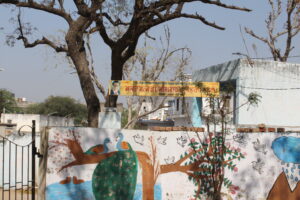
The neighborhood in Neemrana, where one of Kalaa’s workshops is located.
The women in the room chat with each other and me while crocheting small yellow and green squares. They mention how Neemrana has a Japanese SEZ (special economic zone) across the highway, where many of their fathers, brothers, or husbands work. One young woman says her mother works in a plant there making steel rings for tyres. They tell me there’s not much else to do here. One woman, who came to the industrial town after marriage, says she doesn’t like it and hopes her children find jobs in Delhi or Gurgaon. Another woman with a soft chuckle, counters that it isn’t that bad and asks me to sing. I laugh and hiccup my way through a 1980s’ classic Hindi track, “Mera Dil Bhi Kitna Pagal Hai”. She joins in, singing much better, so I stop. Twenty minutes later she has sung four incredible Hindi songs and is onto her fifth. When I ask her about one of the older songs I didn’t recognize, she says she has only heard these songs on the radio.
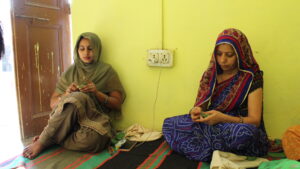
Women crocheting in the Kalaa workshop.
Most of the women I am speaking to are part of an initiative by Good Business Lab and Kalaa Sakhi, providing flexible paid opportunities to women. The project has two arms: one group of women work at a workshop, crocheting squares for Kalaa’s handicrafts, while another group does the same work from home, in a more flexible manner. Kalaa collects the raw material regularly and sends it to their centers to be made into products like quilts and coasters.
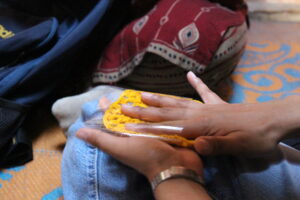
An enumerator packing the squares crocheted by women participants.
Initially focusing on rural women in places like Jharkhand and Karnataka, the current project in Neemrana represents a shift to a semi-industrial town with little agricultural work for women to engage in, and from making finished products to producing raw materials.
The Rajasthan State Industrial Development & Investment Corporation (RIICO) has attracted major Japanese companies to Neemrana to set up production facilities. [3] Today, the town’s economy depends on this Japanese zone and its 15th century fort, which boosts tourism. Agriculture is limited but animal husbandry remains common with goats dotting the roads almost as much as Neem trees, the town’s namesake.
The first house we visit has two goats penned outside the door. The women living there are pairs of sisters who marry into the same household, a common agreement in the area. In rural areas, women juggle agricultural work with domestic duties. That could mean weeding fields, waking up at 5 AM to feed or milk cows, caregiving an elderly or minor member at home, walking kilometers to draw water, or of course, cooking. But in Neemrana, women’s challenges are different. There are almost no farms left; produce comes from roadside vendors, and water is delivered to their doorstep, with the labor of collection performed by women.
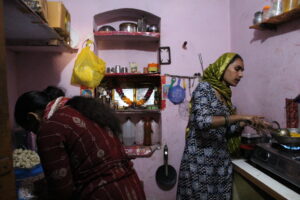
One of the women cooks lunch while responding to the time-use survey.
The women we spoke to had varying responsibilities. One pair of sisters married into the same home cooks and packs momos and sauces for their husbands’ businesses. They clean the shop with their husbands, but unlike their husbands, they cook three meals a day for a family of more than 8. They find time to crochet between lunch and dinner, often while watching TV or chatting through an iron grill in the central courtyard. The squares must be perfect. The sisters, like all participants, received training from instructors who live nearby if they ever needed a refresher. Six holes climbing up diagonally to the four corners of their crocheted square. One sister helps the other who is slower to catch on. In a sibling manner my mother would find similar to my sister and me, the younger one fires back that she does them perfectly but just takes longer.
We then visit another pair of sisters married into a wealthier family. The older sister is one of the most skilled in crocheting, making 10 or 11 squares in the time others, including her sister, make 5 or 6. The other sister is upbeat, enjoying her marital home with few demands. In contrast, the older sister is more somber and finds life in Neemrana busy and exhausting, juggling more domestic work and frequent odd jobs. During the pandemic, the younger sister briefly took online tailoring orders, but the older sister’s workload remained heavy.
The older sister also adopted a girl. This surprised me. My mother’s struggles with having two daughters is still a strong memory, especially in the context of Rajasthan which ranks 30th in child sex ratio. [4] The girl was, originally her niece, one of twins. Having always wanted a daughter, but only having boys. The older sister now spends most of her earnings from GBL’s project and other work on her adopted daughter. She proudly shows me dresses and plastic jewelry, her eyes sparkling for the first time “I even buy her chips,” she says.
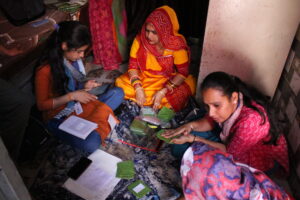
Enumerators conducting a time-use survey and collecting finished crochets.
The flexibility of fitting crocheting around other responsibilities has been crucial. This sentiment echoed throughout GBL’s time-use surveys. Women working from home, provide critical raw material for Kalaa, while juggling other paid and unpaid tasks in segmented periods. For the four sisters we spoke to, non-crochet work was concentrated at the beginning and end of the day. A young mother, married into a smaller family (again, with her sister!) held her toddler and mentioned considerably shorter breaks resulting in fewer crochet squares. While working from home offers flexibility, the workshop where another group crochets has become a unique social space.
In Neemrana, large banyan trees, corner stoops, and empty grounds are common gathering spots for men and a few elderly women. They sit, talk, and sometimes play cards. Two older women sit on rickety plastic chairs outside a small shop. When I say I’m from Bombay, one tells me to feel comfortable, and the other says every woman here is like my mother, sharing a sense of belonging. This same sense has sprung up in the workshop where two to seven women crochet while laughing and talking. There, I met a woman from Bihar. Her husband’s transfer brought her to Neemrana only a few years ago. She had never been allowed to work professionally but her husband agreed to this initiative because only women were present in the workshop. She can produce more than double the number of squares as most other participants. She said it felt good to be there because she was finally able to leave the house.
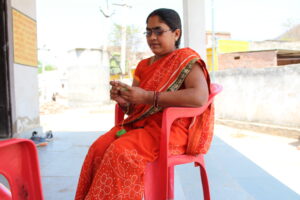
A woman crocheting in the second Kalaa workshop.
For some women, staying at home provides the opportunity to earn while managing daily tasks. For others, the chance to leave the house even for a few hours allows them to earn and change their routine. Both realities are important and require support and interventions that adapt to women’s contexts are more effective.
Women make up 75% of farm workers in India. [5] But what about women in slowly industrializing towns built on drying rivers and receding farmland? Many are migrants without support networks or employment amenable to their lives. Good Business Lab’s initiative, in partnership with Kalaa, aims to address this in Neemrana.
Check out our projects designed to enable women to engage in paid work and firms to reach untapped labor.
Have any thoughts, ideas or questions that you would like to share? Write to nihira.r@goodbusinesslab.org.
Citations:
[2] A Statistical Portrait of the Indian Female Labor Force
[3] Rajasthan’s Neemrana town turning into a hub for Japanese industries
[5] Empowering India’s women farmers: Bridge the gap – Hindustan Times